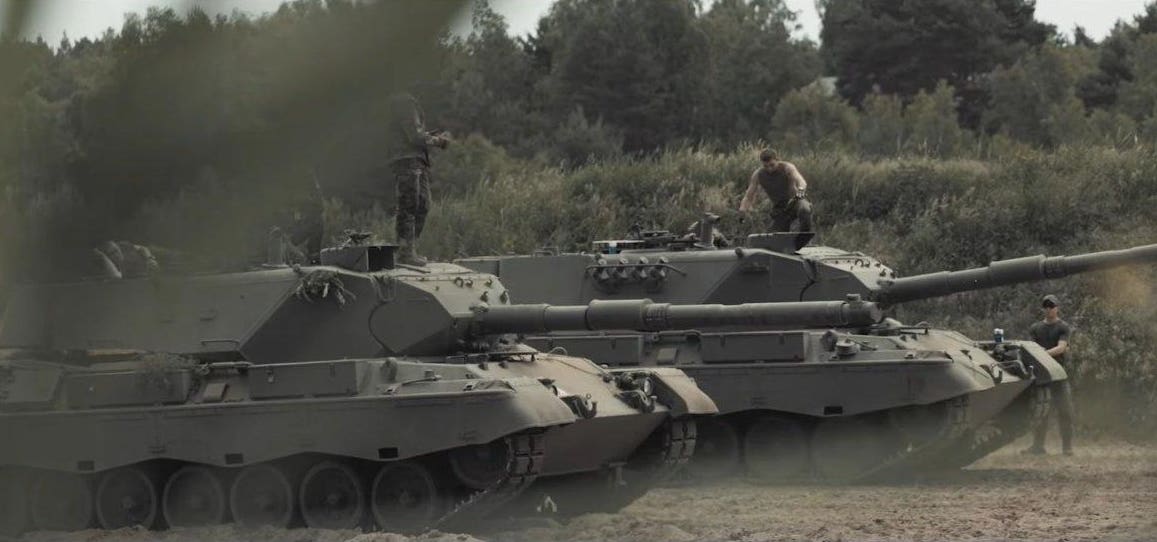A Danish instructor has some advice for the Ukrainian troops he’s training to operate German-made Leopard 1A5 tanks—advice that could help the Ukrainians to survive despite their new tanks’ very thin armor.
Keep moving, shoot at long range and fight at night, advised the middle-age instructor, who presumably crewed a Leopard 1A5 back when the type served the Danish army, 20 years ago. “If they use it as we teach them to use it, and they take advantage of the positive difference the Leopard 1A5 has versus any of the tanks it’s going up against, then I definitely believe it will make a difference.”
The first 10 of 178 1980s-vintage that a Belgian-Danish-Dutch-German consortium is donating to Ukraine—drawing from former Belgian, Danish and German army stocks—already have arrived in Ukraine, where they apparently equip a company within the new 44th Mechanized Brigade. The brigade is fighting a defensive action against Russian regiments west of Kreminna in northeastern Ukraine.
The Leopard 1A5 is set to become Ukraine’s most numerous Western-made tank, outnumbering the 14 British Challenger 2s, 31 American M-1s and 85 European Leopard 2s Ukrainian brigades already have received, or soon will receive.
The Leopard 1A5 consignment could be bigger, but neutral Switzerland has refused to approve the transfer of a batch of the tanks belonging to a Swiss company. And rumors of a complex, circular deal involving these tanks—a deal that would have sent them to Greece in exchange for Greece donating some of its own active Leopard 1s to Ukraine—apparently are just that: rumors.
The 40-ton, four-person Leopard 1A5 isn’t like the other Western-made tanks in Ukrainian service, all of which tip the scales at nearly 70 tons. The Leopard 1A5 is light—and that lightness mostly comes from armor that’s just 70 millimeters thick at its thickest. That’s a tenth the protection that the best Leopard 2 enjoys.
To survive on a battlefield thick with mines, prickly with anti-tank missiles and stalked by heavier Russian tanks, the Ukrainian Leopard 1A5 crews should take advantage of their tank’s excellent day-night optics and precise fire-controls and multi-axis gun-stabilization for its 105-millimeter main gun.
The ex-Danish and ex-German Leopard 1s have the same EMES fire-controls as the newer Leopard 2. The ex-Belgian Leopard 1s have unique SABCA fire-controls that might be even more precise, albeit harder to support.
A skilled Leopard 1A5 gunner under the right conditions might be able to hit an enemy vehicle at a range of two miles in daytime and somewhat shorter range in nighttime, making the Leopard 1A5 nearly as capable as a Challenger 2 with its bigger 120-millimeter gun. It’s worth noting that one Ukrainian tanker described his Challenger 2 as a “sniper rifle.”
But the Ukrainian 82nd Air Assault Brigade recently lost its first Challenger 2 on a road outside Robotyne, a key strongpoint that Ukrainian forces recently liberated along the main axis of their counteroffensive in southern Ukraine’s Zaporizhzhia Oblast.
The tank apparently struck a mine then got finished off by explosives-laden drones. That first Challenger 2 loss, as well as the loss of six Ukrainian Leopard 2s, is a reminder that the Ukraine battlefield is a dangerous place for even the toughest tank.
The 82nd Brigade apparently mostly had been using its Challenger 2s as long-range direct fire-support, firing their rifled main guns from concealed positions. The worst thing the Ukrainians can do with their thin-skinned Leopard 1s is fight from fixed positions—and risk Russian bombardment. The Leopard 1 “is made for driving and shooting,” the Danish instructor said.
“These are some of the things our Ukrainian friends must learn to exploit,” the instructor said.
Read the full article here





